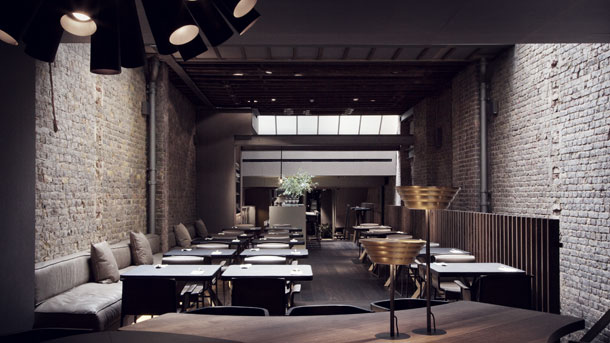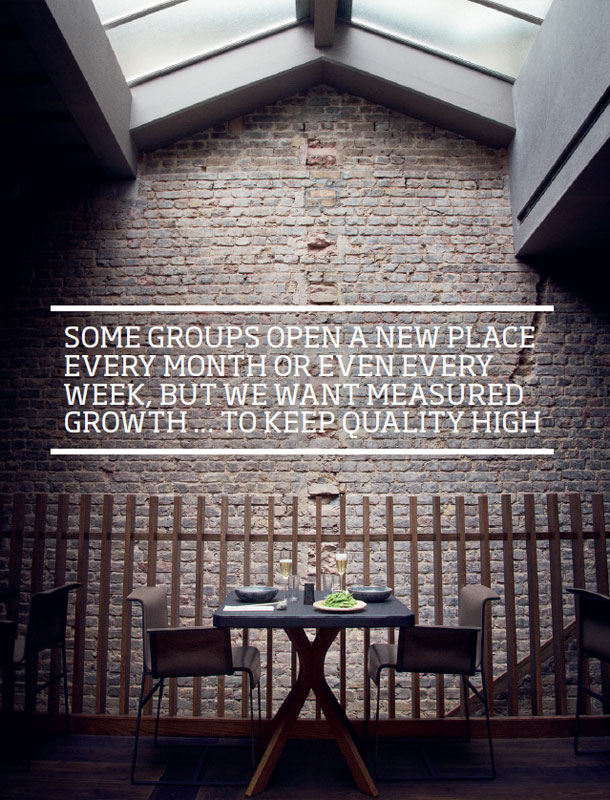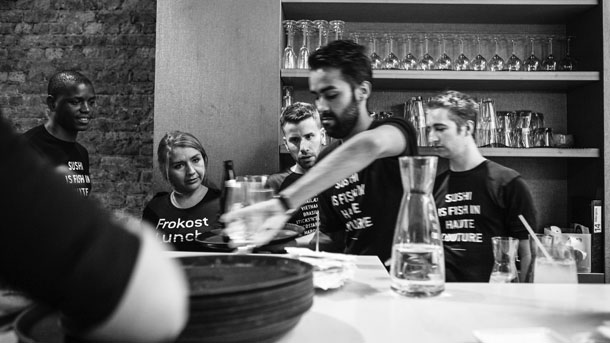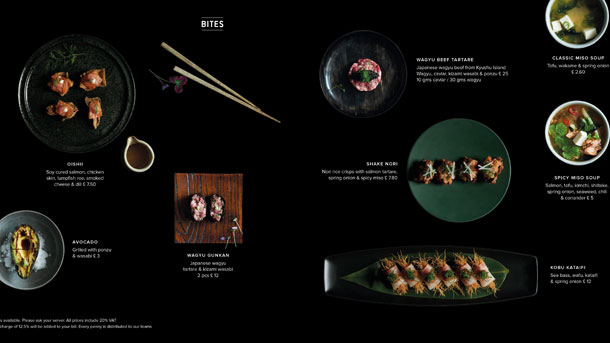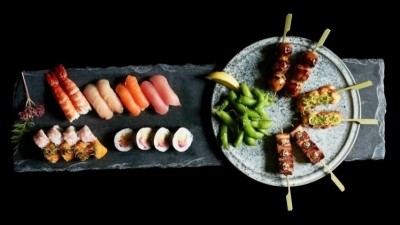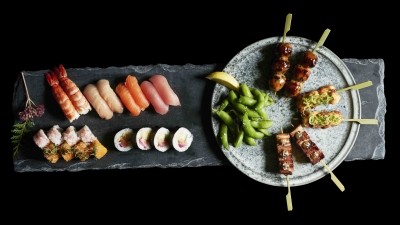Big in Denmark: Sticks'n'Sushi's Andreas Karlsson on its future plans
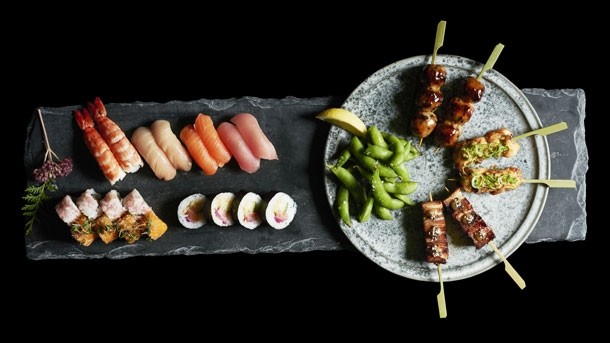
Andreas Karlsson is as Scandinavian as they come.
Tall, with long hair and casually dressed in jeans and a shirt, he is completely at ease in Sticks’n’Sushi’s bright Covent Garden restaurant. Indeed, he’s exactly the man you’d expect to find heading up the UK arm of a Danish-owned restaurant group.
Well, almost. The group COO of the sushi and yakitori restaurant group may live and breathe the Danish-owned business, but Karlsson’s not actually Danish. He’s Swedish.
“Sweden is H&M and Ikea and Abba, rather than Noma, good TV dramas, and hygge,” he says. “Like all neighbouring countries, we don’t get along when we play football, but in the world, we’re the best of friends.”
Swedish import: Andreas Karlsson heads the UK arm of the Danish-owned Japanese group
For some people in the UK it might seem a little strange that either a Dane or a Swede would be running a group of Japanese restaurants, but in Denmark, where Sticks’n’Sushi is a household name, people don’t give it a second thought.
Founded in 1994 by Danish-Japanese brothers Jens and Kim Rahbek, and business partner Thor Andersen, the group is well-established in Copenhagen, two planned for later this year in London Victoria’s Nova development and Oxford.
There are also rumours that a Soho site is not far away.
Measured expansion
Turning Japanese: the company applies a Scandi aesthetic to its restaurants
Karlsson is an obvious choice to head up Sticks’n’Sushi in the UK. The Swede has lived in the UK for over half his life since coming to work at a Tottenham Court Road hotel in his 20s and has had a significant hand in the rise of branded Asian food in the UK.
A key figure behind Wagamama’s UK and worldwide rollout (he started at the group back in 1995 when Alan Yau was still involved), Karlsson has form when it comes to taking previously unfamiliar Japanese concepts and making them accessible to a wider audience. His experience with a restaurant brand that was known as much for its design as its food in the early years has also rubbed off on him.
“Wagamama and Yo! Sushi paved the way for us in the UK,” he says. “And then you had the brands above us – Roka, Zuma, Nobu – that were in London years before we opened. When we opened in Copenhagen, we were maybe educating Danes in Japanese food. But London? London already knew about it.”
It was while rolling out Wagamama internationally that Karlsson met the Sticks’n’Sushi founders, and it’s fitting that as he is telling this story, his phone goes. It’s Kim Rahbek. “If you’re good at keeping contact and networking, you never know what will happen,” says Karlsson. “Eventually, the family asked me to help make their long dream of opening in London a reality.”
Sticks’n’Sushi’s family-owned status is apparent in its measured approach to expansion. The founders never had ambitions to make the brand as ‘roll-outable’ as possible, says Karlsson, and UK growth so far has been slow and steady.
The company has averaged fewer than one restaurant opening each year, although the plan now is to quicken growth slightly and to open one or two UK restaurants per year, ideally not too close together. International expansion has been equally glacial, with just one other restaurant outside of Copenhagen, in Berlin, opening in late 2016.
Unusually, then, later this year two UK restaurants will launch, with Nova opening in October and Oxford a month later. “That’s too close for two openings for my liking,” admits Karlsson. “Nova was supposed to open much earlier. You need to have your support team fully concentrating on one restaurant before they move on to another one.
“I don’t particularly like the term ‘roll out’,” he adds. “Some groups open a new place every month or even every week, but we want measured growth. It’s natural that we would grow, but we need to keep quality high and ensure that we deliver.”
Opening scene: The group has four restaurants and two planned for later this year, in Victoria's Nova development and Oxford
A broad offer
A look a Sticks’n’Sushi’s menu provides a clue as to why the brand might not match other burgeoning restaurant groups in terms of pace of rollout.
The company’s food offer is broad, and changes every six to nine months, with everything from a small bowl of miso soup, simply-dressed tataki, and seaweed salad to enormous six-person platters of seabass and scallop daikon rolls, miso marinated black cod, duck heart skewers and Japanese wagyu.
There are 15 different variations of nigari on offer, 16 different maki rolls, 18 yakitori options and 12 desserts.
The menu primarily focuses on sharing plates with numerous options designed to take the pain out of having to choose individual items. Sharing dishes are priced for both two and three people – its Perfect Day selection of sushi and yakitori is £65 for two, £87 for three, for example – and the desserts, such as the liquorice crème brûlée and matcha chocolate cake, come in small portions to encourage groups to try more (or all of them – the Taster option offers diners a sample of each for £30).
The ebi bites (fried tempura prawns with chilli) are the company’s bestselling dish. The ingredients themselves come from as close by as possible, with the UK restaurants using Scottish salmon rather than the Norwegian found in the Danish sites, for example, but some specialist ingredients are still shipped from Japan.
The drinks list shows serious confidence too, with an impressive selection of original Japanese cocktails, such as The Nippon made with shisho, shochu, lime and prosecco; The Takersuru, with Nikka From The Barrel whisky, fresh ginger, matcha powder and citrus; and the simple Yuzu Zoo, made with gin, yuzu juice and plum wine.
Japanese whiskies start at £12, hitting £17 for the Hakushu 12 Year Old and the sake list is comprehensive, with a daily changing small ‘cold glass’ for £7.50.
Tea significantly outsells coffee at Sticks’n’Sushi, and it’s not hard to see why: the wide selection features options such as genmaicha (green tea with popped rice), hojicha (toasted green tea), the slightly more-familiar matcha latte, and an in-house blend of liquorice and mint, which is dubbed a very hyggeesque ‘Coziness’.
The soft drinks menu also dodges the usual predictability with a Danish fruit and brown sugar drink from Ebeltoft Brewery as well as Jax coco water, iced matcha, rhubarb fizz, and Danish elderflower.
Given such variety, it’s unsurprising that the average spend “has an elasticity to it”, says Karlsson. “You have people coming in here eating lunch for £15 a head,” he says. “They have their sushi rolls, a cup of miso and a pot of tea. But then others come in and say, ‘I want that platter, that platter, and a bottle of wine and four cocktails’. They are on a different mission.”
An international workforce
Karlsson: "Kitchens really are the united nations of countries"
With over 250 staff in the UK and 750 in Denmark, and with two large restaurants about to open, the issue of staffing is starting to raise its head. “The industry is booming, so it’s really tough to find staff,” says Karlsson. “So you need to identify talent from within, and have interesting things going on – such as opening internationally – so staff can work abroad and feel proud. If you care about the team, you should do your utmost to allow some to go part-time, or allow a full-timer time off to do a course, or do longer days with more days off.”
Brexit is unlikely to help the issue, yet Karlsson is hearteningly optimistic about how the UK’s decision to leave the European Union will impact on his business.
“I do know that Brexit will not stop people eating out,” he says, confidently. “Challenges exist around attracting the workforce, but the government knows how important this industry is, and will protect it somehow. Are we going to give up? No chance.
“Many of our chefs from Denmark have come to London and vice-versa. Kitchens really are the united nations of countries. Living in a different country is a great school for young staff, and we want to be young at heart and young in mind.”
It’s a fittingly personal, warm metaphor for a family-based business, and it seems Karlsson’s got Sticks’n’Sushi firmly under his wing. Even if he isn’t Danish.
Getting flashy with food
How Sticks’n’Sushi broke the menu mould
In Europe, using photos to illustrate food is often a no-no, and is an approach usually reserved for tourist-trap restaurants and expat greasy spoons. Yet, in Asia, and particularly Japan, the trend is reversed, with all but the most high-end restaurants photographing their food. Sticks’n’Sushi is in the latter camp and photographs every single dish on its menu. Its sleek booklet is filled with 133 shots of artistic photography, laid out on shiny black paper, with liberal pops of bright colour to catch the eye. It’s even entitled ‘Photo Album’, rather than ‘menu’ with the motto ‘Look how it tastes – words are good, pictures are better’.
“It’s become part of the brand and how we communicate, and we put a lot of time and effort into it,” says group COO Andreas Karlsson. “The preconception about menus using photography to explain their food is that the food never looks as good when it comes out. But it keeps us on our toes. When the food arrives it should really outperform what the guest expects from the menu.”
Although the photos chime with today’s Instagram-obsessed age, the photography at Sticks’n’Sushi actually began back in 1994, when some of the founders had previously worked in magazine printing, and so understood the power of a good visual.
Printing photos of the food was also a necessary move, back when customers were less familiar than they are now with the concepts of miso, dashi, yakitori and nigiri, not to mention Japanese desserts.
This feature originally appeared in the June 2017 issue of Restaurant magazine, and was adapted for online by Hannah Thompson. Subscribe to Restaurant magazine from just £63 a year, here!

